IT-subsystems of the sports center: pre-reality, safety, medicine, points, etc.
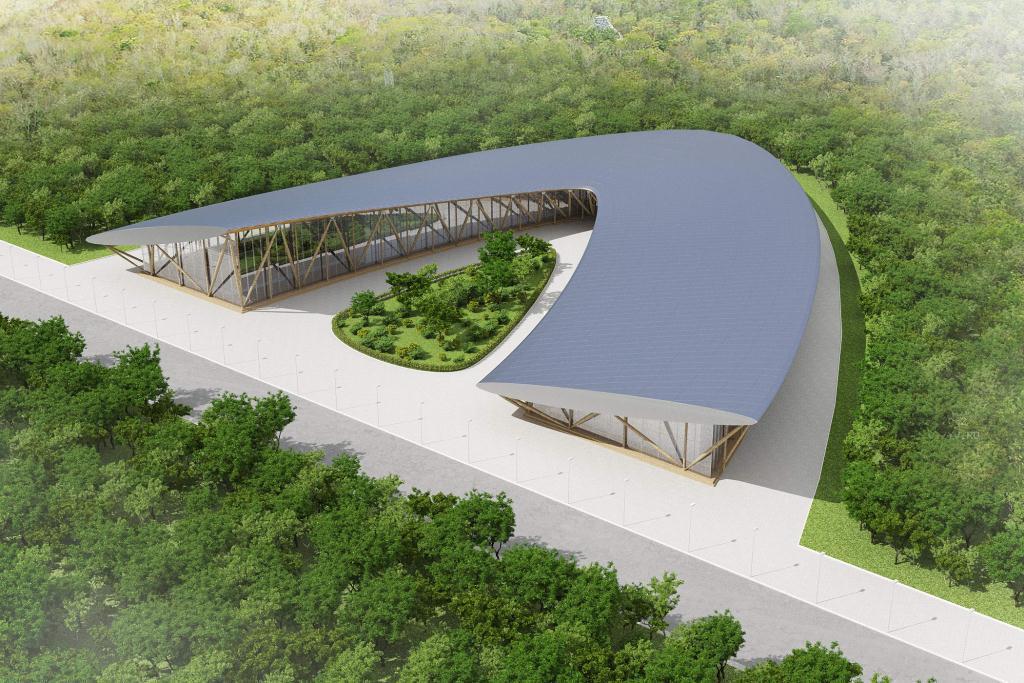

Our task was to build a conditional layout of a sports center equipped with the most modern IT technologies. We showed the result at the SPORT exhibition.
Here is what we put together in one complex:
- LED navigation gym floor.
- Data collection from bracelets (with RFID tags).
- Instructions for simulators in augmented reality.
- Content management.
- Automatic point fixing systems in tournaments.
- Various projection systems.
- Telemedicine system.
- Autonomous management of engineering systems.
- Security, video analytics and anti-fire measures.
- Situational center for managers: visual economic and engineering indicators, forecast estimates for decision-making, etc.
Come on, show it.
Entrance:

Top view:
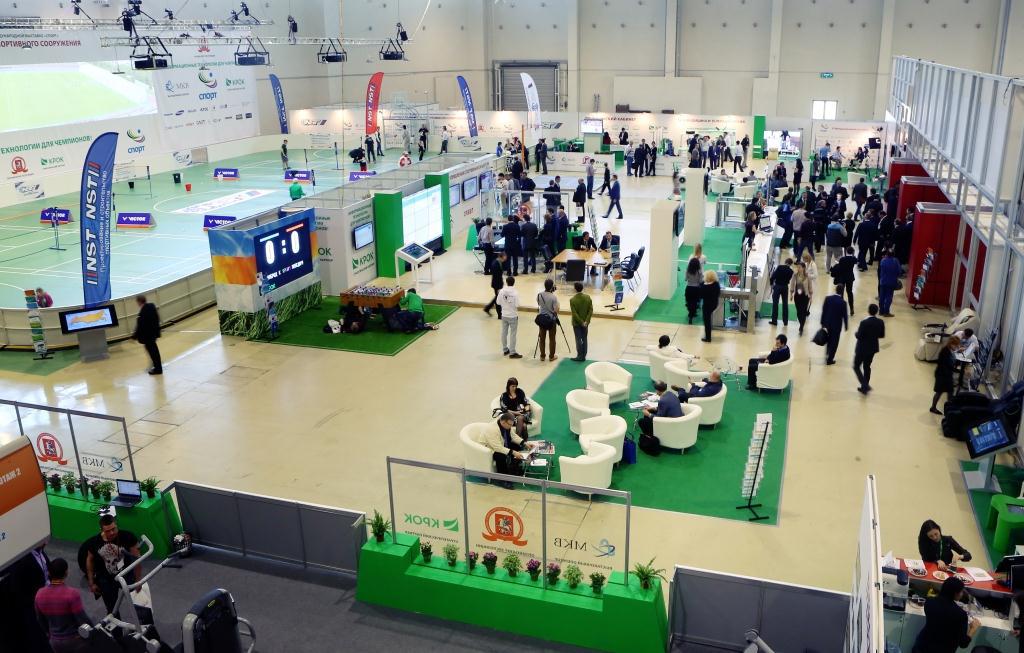
Access
It all starts with access control systems at the site. These are the turnstiles equipped with RFID readers that stood at the entrance to our sports center. In principle, it could also be the 3D face recognition technology that we already liked (we have a very cool recognition PAC that distinguishes even twins with earflaps and black glasses), but RFID bracelets in the sports center can solve additional problems.

For example, the bracelet may have heart rate sensors. It is convenient to look for the bracelet inside the sports complex to assess user flows and equipment loads (which in the long term means more uniform wear of the simulators). An RFID chip can be integrated into the bracelet, opening “your” smart locker. On it you can register in the information kiosk system and fix the training program or pay for purchases in the fitness bar, and not carry cash with you, which is very inconvenient to deal with.
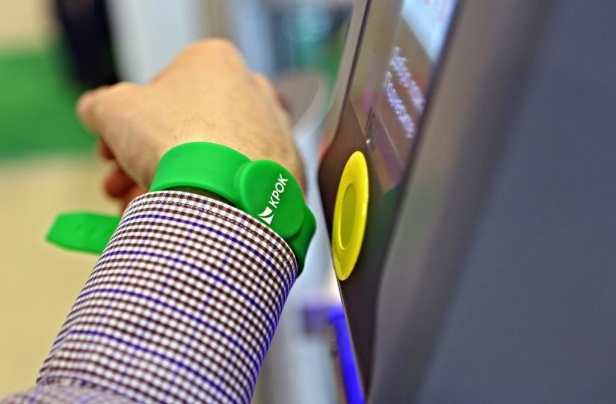
Content management
In the simulators, it was important not only how cool and functional they were, we enhanced this functionality with the ability to connect to a content management system. At the top of the simulator you see a touch panel on which you can run a movie, a progress bar of lost calories or a heart rate monitor from the same bracelet. Or all at once. True, I suspect that the most useful feature will be watching TV shows on the simulator:
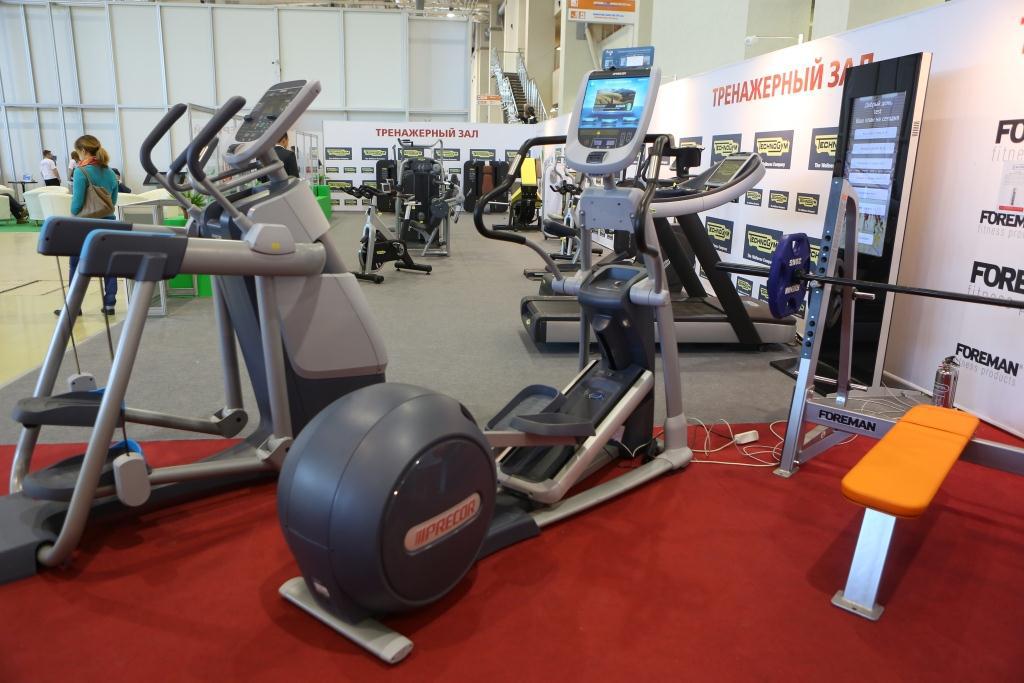
Instructions
The next thing in our layout of the sports center is augmented reality. Point the camera of a tablet or smartphone to a special label that can be applied to anything (for example, on the simulator itself or next to it), it is recognized by the augmented reality mobile application. It loads the prepared content. We had it this way: a person appeared on the screen, approached the simulator, showed how and what to do and in what sequence, with a separate color in the process of visualizing 3D content it was possible to see which muscle groups were involved in this exercise.

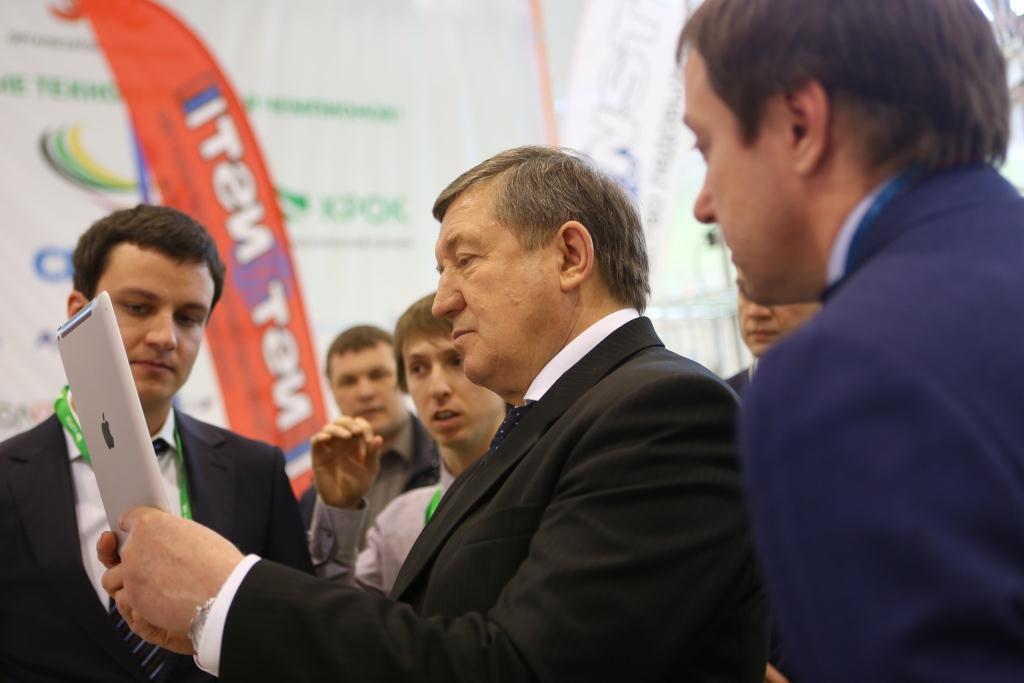
LED floor
Here we show the Minister of Sports gender with variable markings . LED marking on it allows you to quickly “redraw” the situation depending on the type of competition. In Europe, these are already being used. The coating of a special translucent, lightweight, impact-resistant material has also passed the necessary certification in Europe.
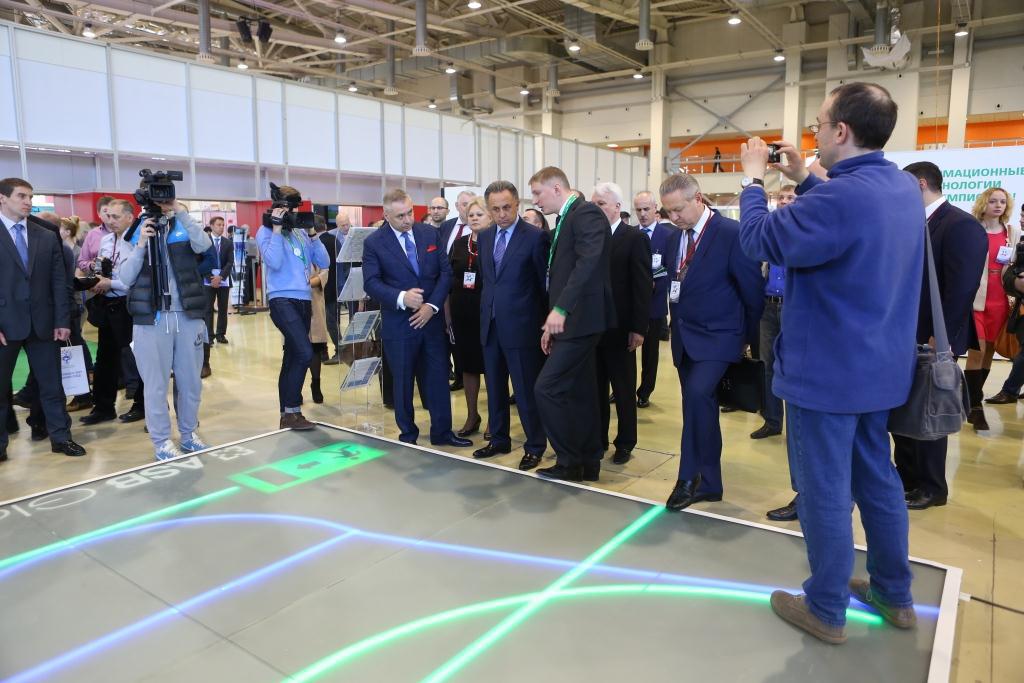
Tournament table
This one would not differ from those that are now in many institutions, if not for the LED screen nearby and a system for fixing goals scored. The same automated systems can be screwed to any analog tables - at least table tennis, at least chess (although recognition will be more difficult there).

Information and entertainment
There were a lot of interactive tables, shop windows, stalls and screens in the layout. They can be used to obtain data on the workload of the halls, the formation of individual programs, navigation through the sports complex and so on.
Below is just an interactive showcase. On the screen (and, in fact, it is glass with a transparent interactive film), the content (photo, video, whatever) corresponding to the contents in the window is displayed. For example, in any sports center there is a “museum” of cups, medals, etc. You can put them in such a display case, and on the screen show the history of each of them. At the same time, content can be manually moved around the storefront, zoomed in and out, deleted and downloaded new, in general, “played” in different ways.

And here we have an interactive table with children's games. Accordingly, most of the games about "slap on a colored spot" and so on - develop mindfulness, coordination, reaction and other abilities. It seemed to us that a small children's corner is often not enough in sports complexes.
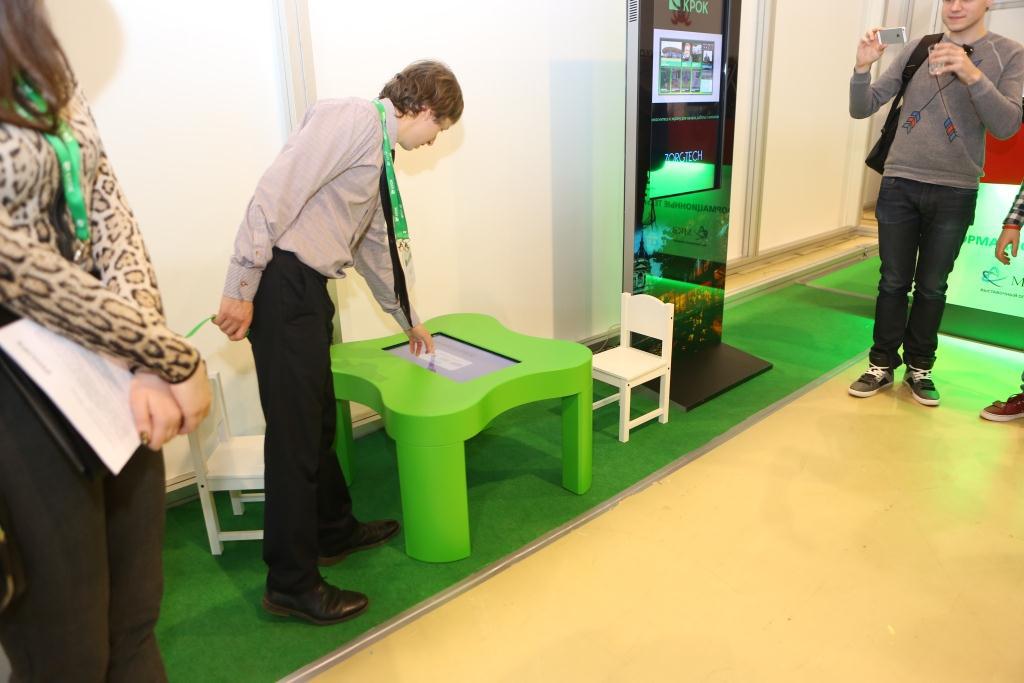
We move to the sports ground. Here behind the player’s back is a large projection screen measuring 4 by 20 meters. The image on it is displayed from the projector system, while the image is smoothly stitched. There are two stitching techniques: pixel-to-pixel and overlay. When superimposing the same zone at the border of the frame, two projectors can show at once: this allows you to maintain brightness and avoid all sorts of seams.

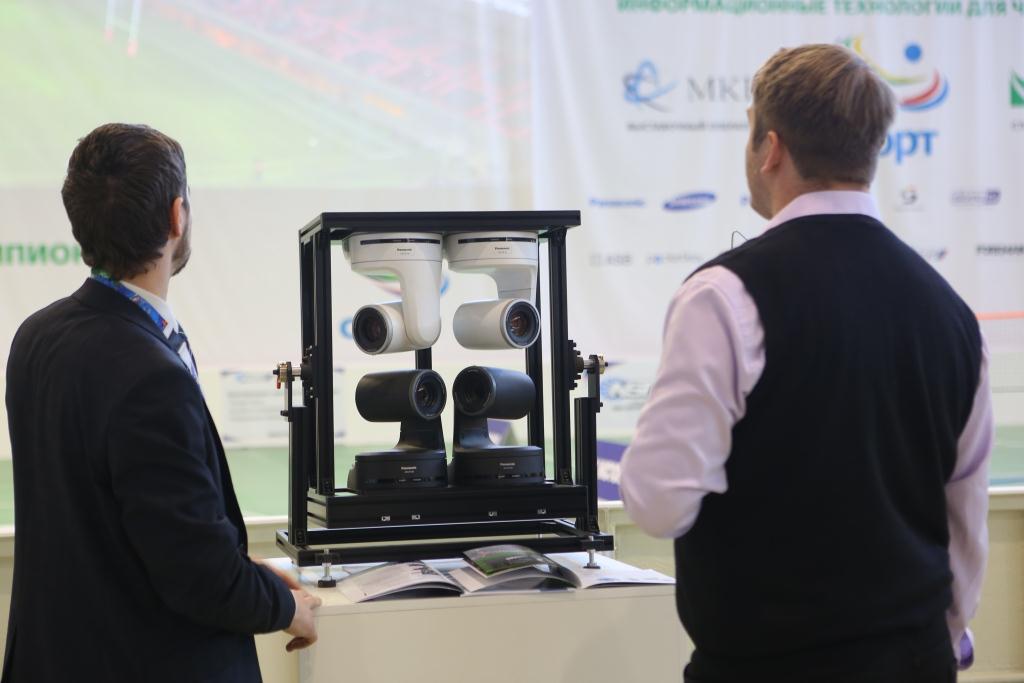
Camera system (part of the projection system)
Telemedicine
Medical unit . In this particular case, doctors conduct remote consultations. This is the same telemedicine about which so much is being said. You can go into the office of the sports center (and in fact also the polyclinic, sanatorium, school, student or factory medical center, you can even put it at home) in Izhevsk, use the automatic complex for ECG recording and enable video communication with the doctor. “Something is bothering my heart, here is my ECG, doctor” - “And let's measure the pressure” - and send right there data from another automatic meter, - “So-and-so, do you smoke?” - and further on the situation . Such a telemedicine complex can produce up to 150 different measurements and analyzes. Most of them can be carried out by the patient on their own.
Doctor's
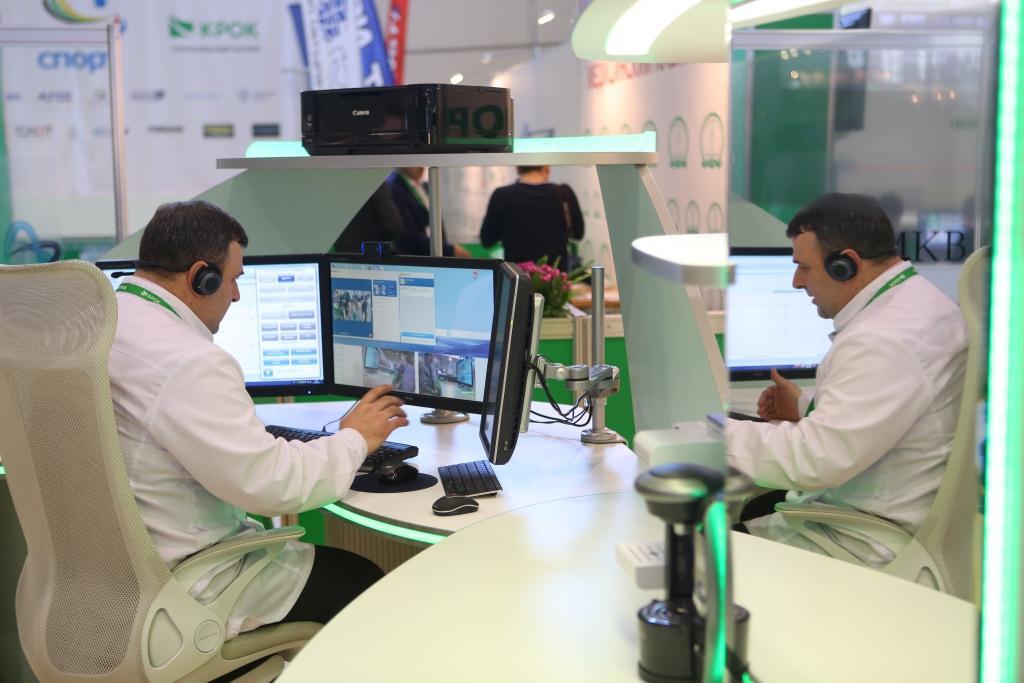
workplace: Patient's workplace:

It can be equipped with an emergency first-aid kit, the funds from which can be used as directed by a doctor. In the case of a sports medical center, you can also upload data from the bracelet here. Then it’s actually a treadmill test.
Situation center
Here is another important area. A kind of situational center for the leaderor curator of a sports development program. Here is an interactive table and a video wall with elements of business intelligence for managing a network of sports complexes. In the program, objects are presented on a map where the user is offered information in several analytical sections: the federal network, the regional level, a separate object. The interface of business intelligence systems allows you to quickly see the status of the branch network in the regions and at individual objects lagging behind the planned indicators, and then examine each of them in detail. To demonstrate the work of such analytics for the leaders of sports complexes and networks, we prepared various scenarios for the development of the network based on historical data and general trends in the country and on the market. This helps you plan your activities one step further by controlling costs and effectively developing your entire network.
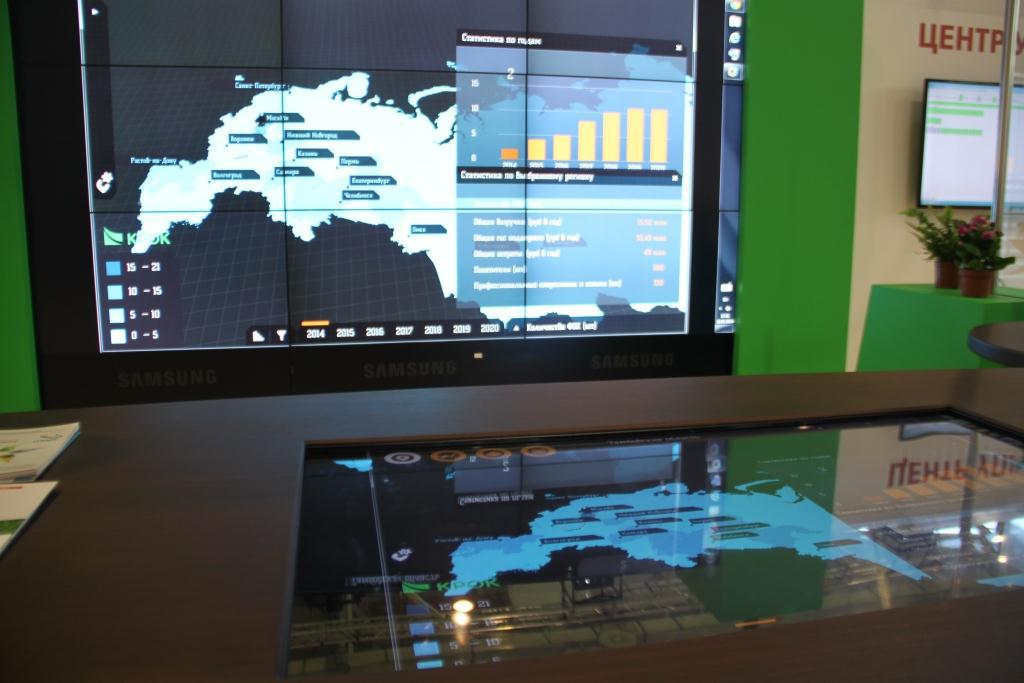
Of course, solutions integrate with facility infrastructure management systems. This allows you to consolidate data on the use of space, enterprise performance, attendance, etc. If suddenly exercise bikes and punching bags are unusually popular in the region - or if their share is gradually growing across the country - the next sports complex under construction will receive a project that takes this fact into account. We put in the complex forecasts for Russia and population dynamics for 2016.
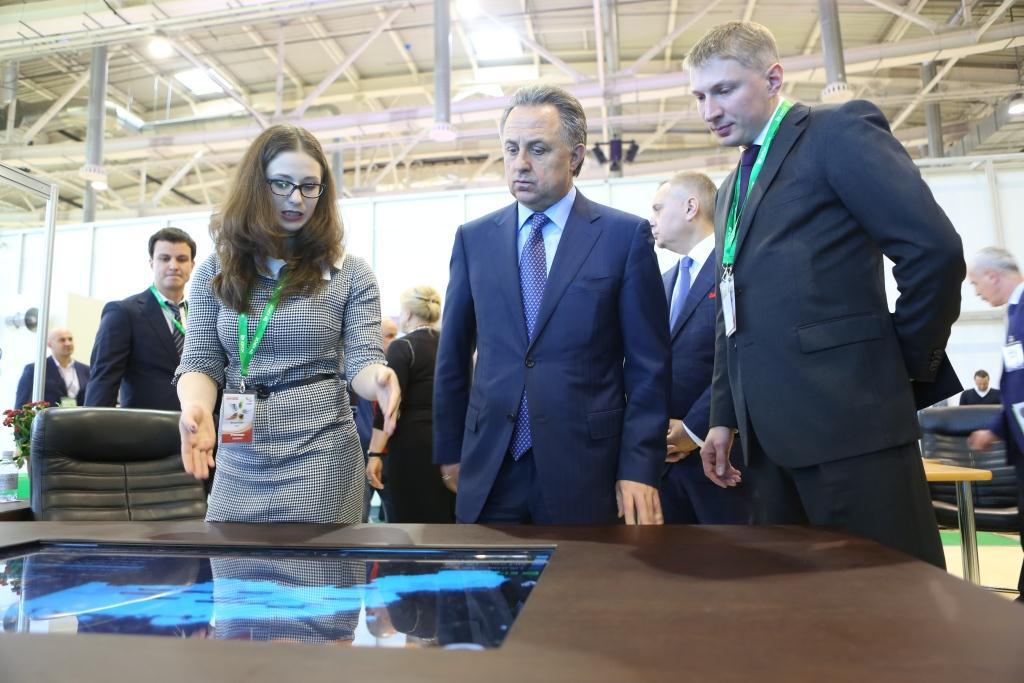
Such a “situational center for the leader” worked through our “cloud”. But, of course, it can work with local servers, and with Amazon, for example.
Whistles
Here in the situation center, we also demonstrated the work of the internal information network , which was built on the basis of Jive. It can consist of user accounts (personal accounts) and event calendars. Here you can synchronize information on height and weight, pressure, heart rate, visit statistics, on which simulators I worked, what I did, on which day for each athlete / visitor of the gym. But the main thing is the social part, with the help of which you can reveal some of the data, set goals and collect likes, support friends. In this case, you can track the target automatically, and catch, for example, that a person has lost 4 kg - and give him a medal for it.
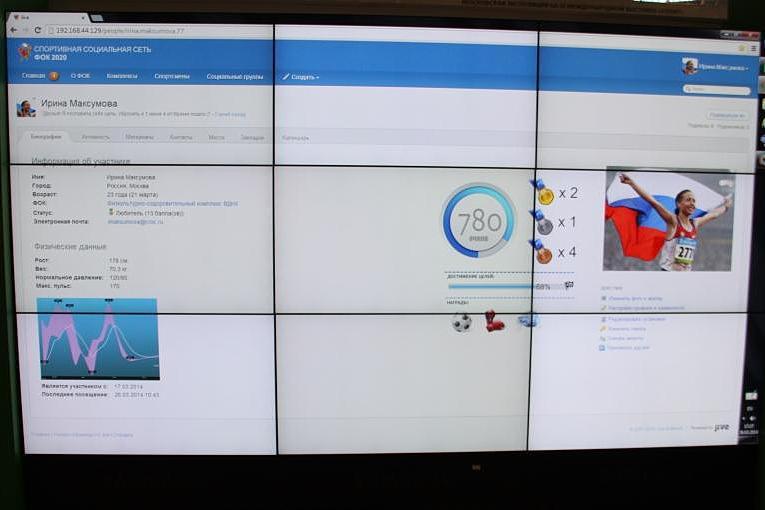
Engineering
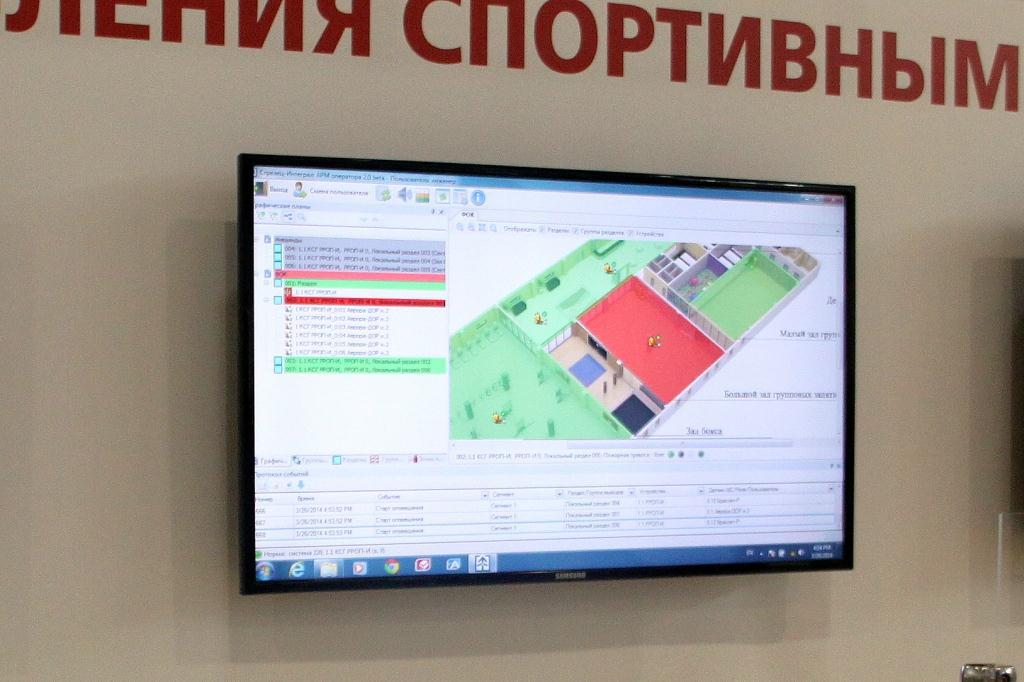

One of the most difficult parts of a sports center is the engineering functionality . We have extensive experience in connecting and integrating engineering systems, so we can say that we ate a dog during engineering monitoring. For example, in two of its offices and three data centers. From a recent one, Sochi airport terminal and 13 buildings were equipped with engineering systems to accommodate Olympic families and the International Paralympic Committee.
In our model of the sports complex, we showed how several levels of engineering systems can be monitored from one remote control. On the “smart” layer, floor plans with an assessment of the effectiveness of the use of equipment and space in general, the state of infrastructure, the degree of depreciation.
A level below - hardware devices for automating the operation of the complex. There are automatic lighting systems for the presence of people, ventilation, depending on the load of the hall and air conditioning. Plus the usual engineering monitoring in the graphical interface and in numerical indicators. Intelligent systems can also be used to manage the meeting rooms and conference rooms in the building. In accordance with the schedule of events, they can automatically change the settings of lighting, air conditioners and other systems, which increases the efficiency of use of equipment and reduces operating costs. All this together can save up to 20% of energy resources and greatly reduces maintenance costs.
For people recovering from a serious injury, or who have received disability, the ability to call for help is relevant. Therefore, they have a special version of an individual bracelet with a large and easily pressed SOS button. When you click on the medical unit, an alarm is sent, plus a room plan with the location of the bracelet is immediately displayed, and if it is in the camera coverage area, you can immediately display the image on the screen.
Evacuation. At a large sports venue, a person will know a maximum of two entrances. More often than not, the one he usually uses. We can use our wireless system together with a heuristic module to build an optimal evacuation route. And output it to all devices that allow you to do this. Including not only the screens of the building, but even individual bracelets (they can lead by voice). In this case, the route is constructed taking into account the prediction of the spread of fire (for example) and taking into account the user's biometric readings - his height, speed, restrictions (the route for a wheelchair user will differ from the master’s route for long jumps).
If it did not work out, the bracelets can be used to find people. For example, at the entrance of firefighters into the room, a security specialist can display a plan diagram in it indicating the position of each of the bracelets.
Security
Video surveillance . One of the main problems of video surveillance at such large facilities is very healthy data sets. As a rule, they are frayed in a couple of weeks, if not days. But now there are already intelligent systems that can highlight key frames (for example, the most distinguishable face in front of the camera on the door) and save only them together with reference to the date, time and any other given data. As a result, the archive is not obtained from the video, but with sufficient data for analysis of the situation, which can be stored for years.
Inside there is a high-level environment and language that allows you to make a reaction according to various criteria. Suppose if at a certain time a person comes into a certain door, accordingly, we take it, identify it, put a photo with this person in a certain network folder, prescribing its route in advance. In addition, you can rebuild from the size of the object and remove the excess background - including the ever-moving leaves.
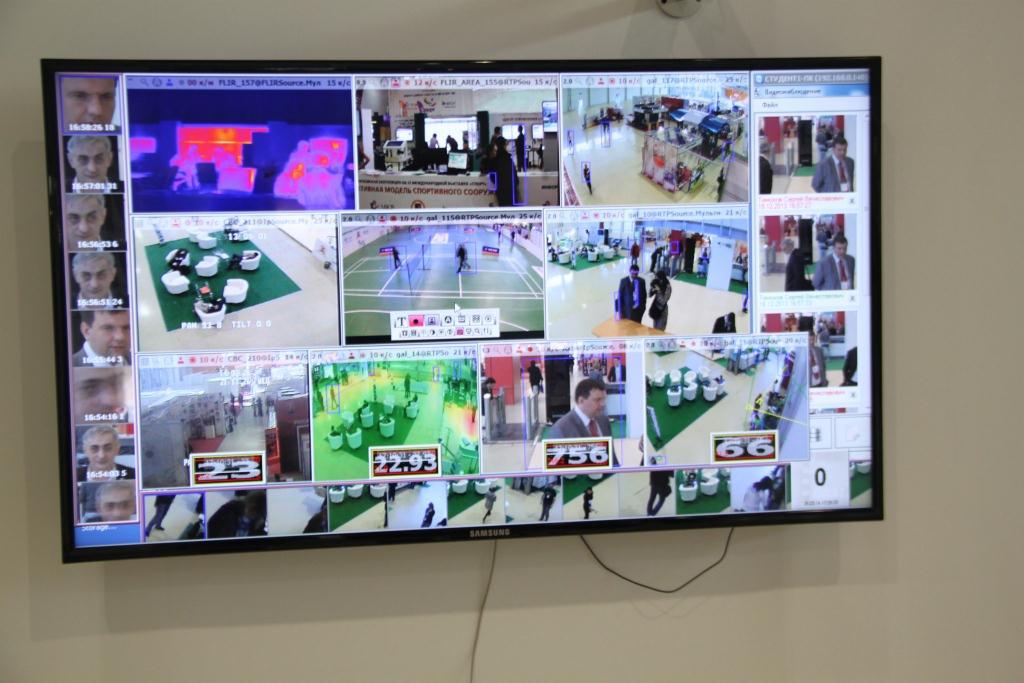
In case of emergencyThere are tools to estimate the number of people in a room, for example, by the number of mobile phones, and if necessary, you can automatically send alarm SMS to their numbers. In general, you can use absolutely any sensors - gas analyzers that catch almost individual molecules (we use such for fire extinguishing systems in our own data center of increased responsibility - even if you suddenly have thin wires in the far rack, we’ll immediately beware), radiation status meters and so on.
Instead of a video camera, you can use a thermal imager , if you put one, for example, at the entrance to a kindergarten, then it is not a problem at all to filter out sick children with fever from healthy ones, or to remove drug addicts from flights, they are usually warmer than a normal person.
“We love answering anonymous questions, Ivan . ” Yes, you can recognize each person at the facility with a probability of collision of 1 to 2.5 million. That is, it is almost like a DNA test - the same error. And this is definitely better than a card and a chip - the face and retina are always with you.
Previously, we worked with the definition of the face and distinguished even the twins with earflaps and glasses. Now we have PACs, which allow taking retinal data “on the go” from 3-4 meters.
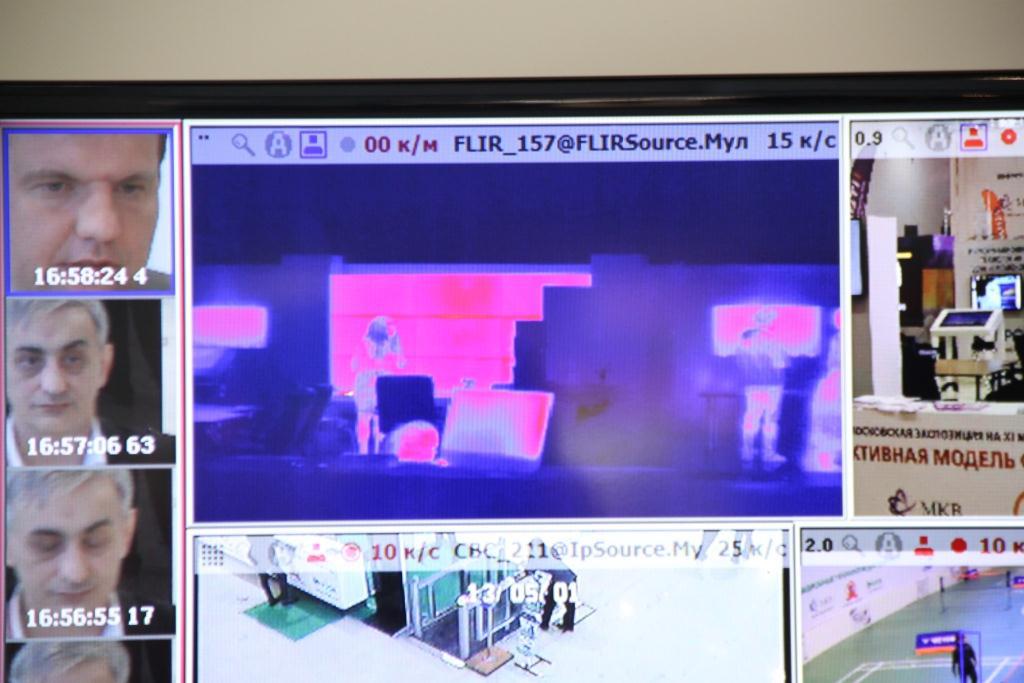
Video Replay
And this is the zone of video judging. Similar complexes are used by the KHL for judicial decisions on violations or the exact determination of difficult situations with a goal.
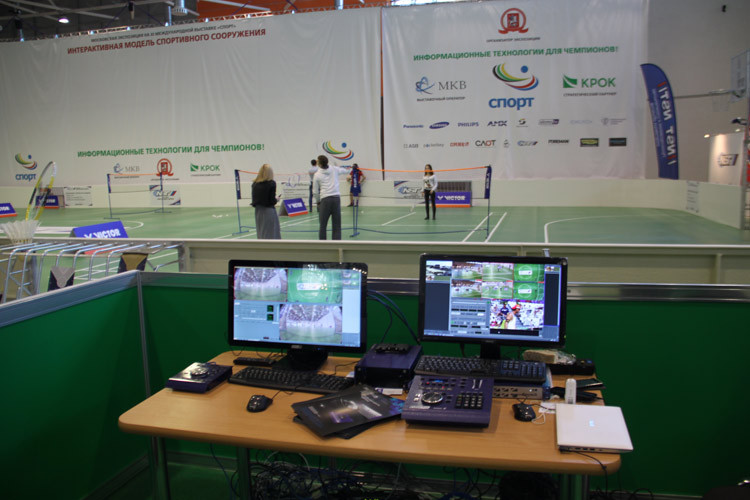
Summary
Our “exhibit” occupied 2000 square meters. And much of this may soon be available in more than 1000 facilities in Russia under the Federal Target Program of the Ministry of Sports, of which 400 have already been built.
As a system integrator, we comprehensively approach the implementation of projects and can do everything - starting with the architectural design and construction of the building itself, ending with equipping it with modern IT solutions. In addition, we conduct tests of the most useful things, test hardware components for wear, bind everything into one system and so on. From the latter, we designed the entire engineer (40 subsystems) for a large stadium. If interested, I’ll tell you in more detail.
What about the future?
As I said, a lot of what we used in our layout of the sports complex is already in use somewhere. However, far from everything in Russia, and nowhere in the complex. Therefore, to some extent, this is the future. But we didn’t stop there and, together with our partner, the architectural group Arch group, talked about how sports complexes of the future might look (from the standpoint of ergonomics, design, comfort, etc.). Here's what happened:


And this is a variant of the internal layout:
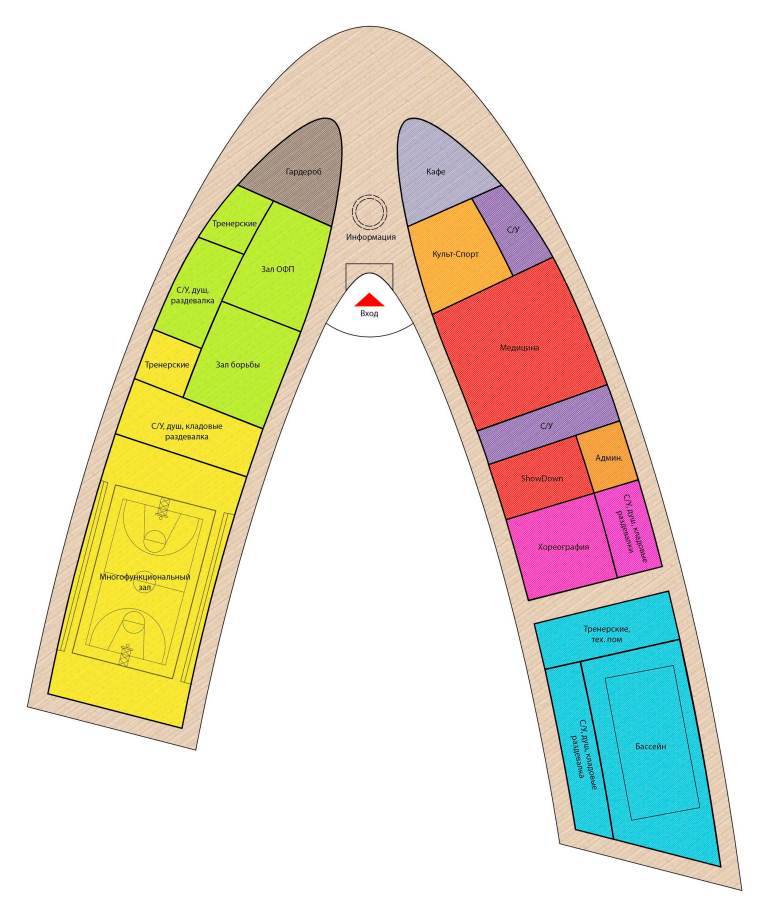
This completes the tour. I will be glad to comment. If you have questions, write in a personal email or e-mail - rmorozov@croc.ru.
